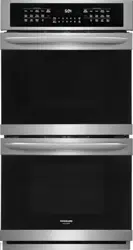Documents: Go to download!
User Manual
- User Manual - (English)
- User Guide - (French)
- Quick Start Guide - (French)
- Quick Start Guide - (English)
- Installation Instructions - (English)
- Product Specifications Sheet - (English)
- Product Specifications Sheet - (French)
- SETTING OVEN CONTROLS
- CARE AND CLEANING
- TROUBLESHOOTING
Table of contents
Owner Guide Wall Oven
SETTING OVEN CONTROLS

Oven Control Features
- Bake - Use to enter normal baking temperatures for recipes that call for regular baking.
- Broil - Selects normal broil function for direct heat cooking.
- Quick Preheat - Best used for single rack baking with packaged convenience foods and foods made from scratch.
- Warm - Use to keep cooked foods at serving temperature.
- OK/START - Use to start cooking functions and when setting the clock.
- Conv Bake - Circulates the oven heat evenly and continuously for baking foods.
- Conv Roast - Uses a convection fan to gently brown meats and poultry and seal in the juices.
- Convect Convert - Converts standard bake temperatures to convection temperature in the convection bake feature.
- Meat Probe - Use when cooking meat like roasts, hams or poultry to cook to the desired internal temperature without any guesswork.
- Bread Proof - Maintains a warm environment useful for rising of yeast-leavened products.
- OFF - Use to turn off all cooking functions.
- Delay Start - Add to Quick Preheat, Bake, Conv Bake, Conv Roast, and Self Clean to program a Delay Start.
- Self Clean - Use to set self-clean cycle between 2 and 4hrs.
- Steam Clean - Use as a time saving method for cleaning light soils.
- Oven Light - Use to turn on internal light. The light turns on automatically when the oven door is opened.
- Timer On-Off - Use to set or cancel the minute timer.
The minute timer does not start or stop any cooking function. - Add 1 Min - Use to add additional minutes to the timer.
- Set Clock - Use set the time of day
- Oven Lock - Use to lock out oven controls.
- 0 through 9 keys - Use to set temperature and time.

Note: An entry acceptance tone (1beep) will sound each time a key is touched (the oven lock key is delayed 3 seconds). An entry error tone (3 short beeps) will sound if the entry of the temperature or time is below the minimum or above the maximum settings for the feature.
Setting the Clock
When the appliance is first powered up, 12:00 will flash in the display. The time of day must first be set before operating the oven.

To Set Clock to 1:30:
- Press
 .
. - Enter 1 3 0 using numeric keys.
- Press OK/START.
Important note: The clock cannot be changed when a Self Clean, Delay Start, or cooking feature is active.
Setting Timer
The minute timer allows you to track your cooking times without interfering with the cooking process. The timer may be set from a minimum time of 1 minute to a maximum of 11 hours and 59 minutes.
To set timer for 5 minutes:
- Press Timer On-Off.
- Enter 5 using numeric keypad.
- Press Timer On-Off to start the timer. When set time ends, END will show in the display and the control will sound a beep three times every 30 seconds until Timer On-Off key is pressed.
To cancel the timer when active, press Timer On-Off again.
Important note:
- The timer does not start or stop the cooking process. It serves as an extra minute timer that will beep when the set time has run out. The timer may be used alone or while using any of the other oven functions.
- When timer is set for more than 1 hour it will display hours and minutes until 1 hour remains. When less than 1 hour remains, the display counts down in minutes and seconds. With less than 1 minute remaining, only seconds will display.
- If the timer is active during a cooking process, the timer will show in the display. To view the status of any other active oven function, press the key of the cooking function once and it will appear in the display for a few seconds.
Add 1 Min
Use the Add 1 min feature to set additional minutes to the timer. Each press of the key will add 1 additional minute. If Add 1 min is pressed when the timer is not active, the timer will activate and begin counting down from 1 minute.
To add 2 minutes to the timer: Press Add 1 Min twice.
Setting 12 Hour or 24 Hour display mode
The clock display mode allows you to select 12 hr or 24 hr modes. The factory pre-set clock display mode is 12 hours.
To set 12 hr or 24 hr display mode:
- Press and hold
 for 6 seconds.
for 6 seconds. - Press Self Clean to toggle between 12 Hr day or 24 Hr day display modes (Figure 5).
- Press OK/START to accept the choice.

Figure 5: 12 Hr dAy and 24 Hr dAy settings
Changing between continuous bake setting or 12 hour energy saving
The oven control has a factory preset built-in 12 Hour Energy Saving feature that will turn off the oven if the oven is left on for more than 12 hours. The control may be programmed to override this feature to bake continuously.
To change between continuous bake or 12 hour energy saving feature:
- Press and hold Timer On-Off for 6 seconds
- Press Self Clean to toggle between 12 Hour OFF or Stay On feature (Figure 6).
- Press OK/START to accept choice.

Figure 6: 12 hr energy saving (L) continuous setting (R)
Changing temperature display from Fahrenheit to Celsius
The electronic oven control is set to display °F when shipped from the factory. The display may be changed to show either °F or ºC oven temperatures.
To change temperature display mode from °F to °C or from °C to °F:
- Press and hold Broil for 6 seconds.
- Once F (or C) appears in the display, press Self Clean to toggle between Fahrenheit and Celsius temperature display modes (Figure 7).
- Press OK/START to accept the choice.
Important note: The oven temperature display cannot be changed during the cooking process or if a delay start has been set or self clean is active.

Figure 7: Display showing Fahrenheit and Celsius
Setting Silent or Audible Control mode
Silent mode allows the oven control to operate without audible tones. The control may be programmed for silent operation and later reset to operate with all the normal audible tones.
To set for silent or audible mode:
- Press and hold Delay Start for 6 seconds.
- Press the Self Clean key to toggle between bEEP On or bEEP OFF (Figure 8).
- Press OK/START to accept the choice.

Figure 8: Display showing audible and silent operation
Setting Oven Lockout
The control can be programmed to lock the oven door and lockout the oven control keys.
To activate the oven lockout features:
- Be sure oven door is completely closed.
- Press and hold the lock key for 3 seconds. The motor driven door latch mechanism will begin locking the oven door automatically. Do not open the oven door. Allow about 15 seconds for the oven door to completely lock. Once door is locked, the words DOOR LOCK with a lock icon will appear in the display.
To cancel the oven lockout feature:
- Press and hold the lock key for 3 seconds. The motor door latch will begin unlocking the oven door automatically. Do not open the oven door. Allow about 15 seconds for the oven door to completely unlock.
- When the words DOOR LOCK and the lock icon no longer display, the oven door may be opened, and the oven control keypad will be available for use.
Important: If a control key is pressed when oven lockout is active, the control will triple beep indicating the key action is not available when the oven lockout feature is active.
Operating Oven Lights 
The interior oven lights will automatically turn on when the oven door is opened. Oven lights will not operate during a self clean cycle. For best baking results, do not leave oven light on while cooking.
Press  to turn the interior oven lights on and off whenever the oven door is closed.
to turn the interior oven lights on and off whenever the oven door is closed.
The interior oven lights are located on the side wall of the oven interior and are covered with a glass shield. The glass shield protects the bulb from high temperatures and should always be in place whenever the oven is in use.
To replace the interior oven light, see “Replacing the Oven Light” in the “Care and Cleaning” section.
Quick Preheat
Quick Preheat is available for single rack baking with packaged convenience foods and foods made from scratch and can be programmed for temperatures between 170°F and 550°F. Follow the recipe or package directions for food preparation time and temperature. When quick preheat is complete, a reminder tone will sound and food should be placed in the oven.
CAUTION: Always use pot holders or oven mitts when using the oven. When cooking the oven interior, oven racks, and cooktop will become very hot which can cause burns.
During quick preheat function, the bake element will cycle on and off. The convection fan will turn on while the oven is preheating and cycle on and off as needed during cooking. Depending on your preference for doneness cooking times may vary. Watch food closely.
Important:
- Always place food in center of the oven on rack position 3 flat rack or 2 Glide rack(Figure 10).
- Place the food as shown in Figure 10.
- For best results when baking batter and dough-based items such as cookies and pastries, use convection bake function and place food in oven when the reminder tone sounds signaling the oven is fully preheated.
- Food may need to be removed early and should be checked at minimum recommended bake time.
To set the preheat temperature for 350°F:
- Arrange the interior oven racks.
- Press Quick Preheat. 350 will appear in the display.
- Press OK/START.
- 350 and QUICK PREHEAT will be displayed while the oven is preheating and disappear when set temperature is reached. .
See other models: FFEW3025LS LFTR2021TF FEB27T6DQ FFSS2314QS FGHD2471KB

Figure 9 - Press OFF when baking is complete or to cancel the preheat feature.
To change preheat temperature while oven is preheating (ex: changing from 350°F to 425°F): - Enter the new preheat temperature. Press 4 2 5.
- Press OK/START. 425 will show in the display.
- When baking is complete, press OFF.
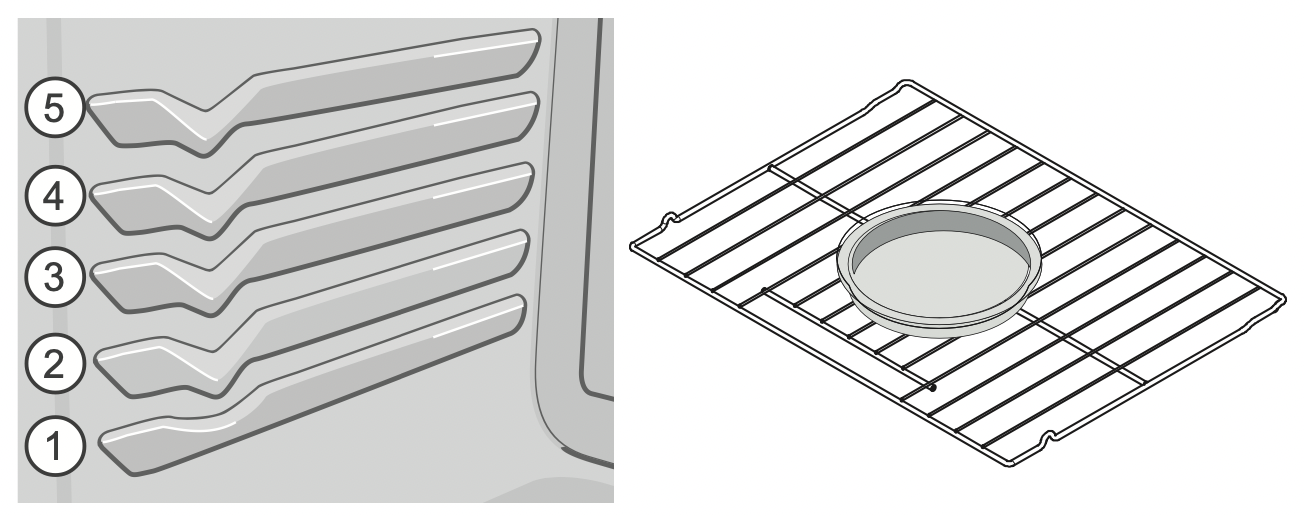
Figure 10: Oven rack positions; single rack baking
Note: The oven is equipped with cooling fans that turn on when the oven reaches a high enough temperature and will remain on until the oven cavity has cooled. In the double wall oven the cooling fan in the idle oven cavity will turn on if needed when the temperature in the active oven becomes hot enough. Cooling fans may remain on for a time after the oven function has been canceled. This is normal.
Setting Bake
Bake cooks with heat that rises from the oven bottom. The heat and air circulate naturally in the oven. A reminder tone will sound indicating when the set bake temperature is reached and to place the food in the oven. The convection fans will turn on in preheat and then cycle on and off as needed during baking. Bake may be set for any oven temperature between 170°F (77°C) to 550°F (288°C).
CAUTION: Always use pot holders or oven mitts when using the oven. When cooking the oven interior, oven racks, and cooktop will become very hot which can cause burns.
Baking tips
- Fully preheat the oven before baking items like cookies, cakes, biscuits and breads.
- Use the convection bake function for best results when baking cookies on multiple racks.
- Bake is the best function to use for baking cakes.
- For best results when baking layer cakes using two oven racks, place racks in positions 1 (flat rack) and 3 Glide rack in the upper oven and place pans as shown in Figure 11. In lower oven place racks in positions 1 (flat) and 4 (flat).
- When using any single rack for baking cookies, cakes, biscuits, or muffins use rack position 4 (flat) or 3 (glide).
- Allow at least 2 inches (5 cm) of space between bakeware for proper air circulation.
- Dark or dull bakeware absorbs more heat than shiny bakeware, resulting in dark or overbrowned foods. It may be necessary to reduce oven temperature or cook time to prevent overbrowning of some foods.
- Dark pans are recommended for pies; shiny pans are recommended for cakes, cookies, and muffins.
- Do not open oven door often. Opening the door will reduce the temperature in the oven and may increase cook time.
To set Bake for (default) oven temperature of 350°F:
- Press Bake.
- 350° will appear in the display.
- Press OK/START.
To cancel Bake at any time, press OFF.
To change the oven temperature to 425°F when the oven is baking:
- Enter new temperature of 4 2 5 using numeric keys.
- Press OK/START.
- To cancel Bake at any time, press OFF.
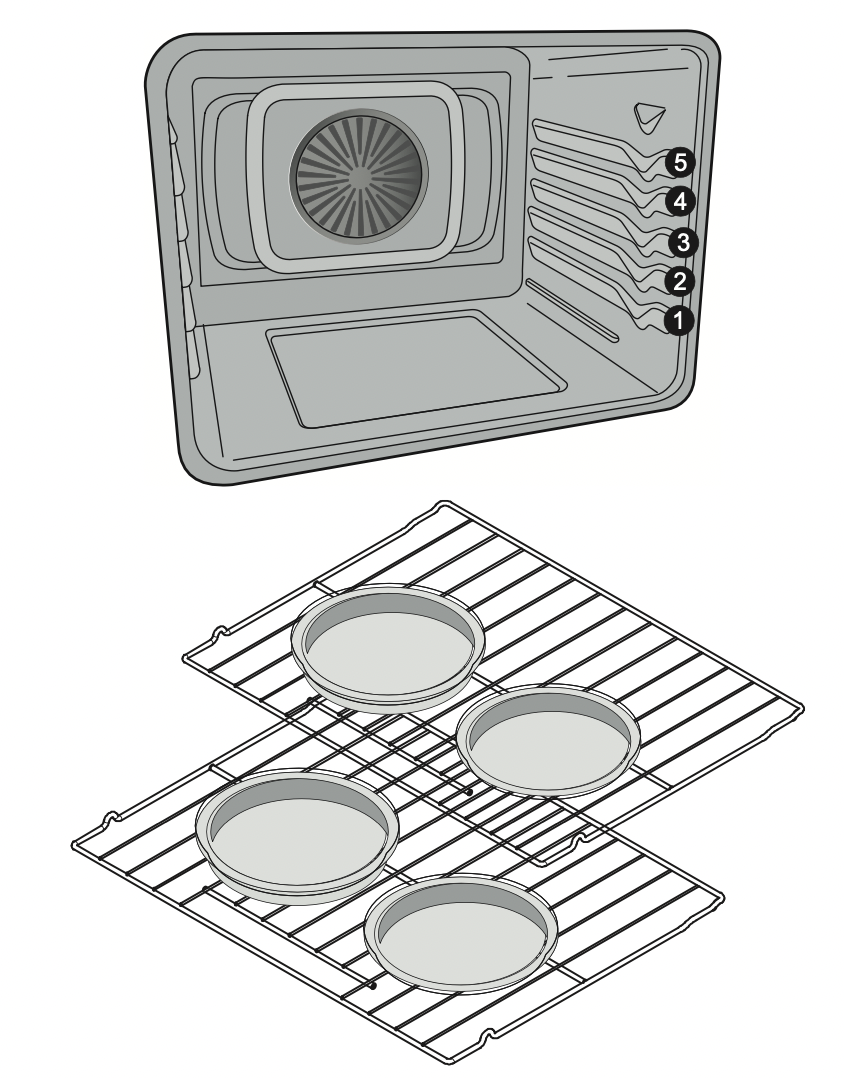
Figure 11: Rack positions and pan placement
Important: The oven will bake no longer than 12 hours. If you wish to bake for a longer period, see “Changing between continuous bake setting or 12 hour energy saving” on page 14 for detailed information.
Convection Bake
Convection Bake uses a fan to circulate the oven's heat uniformly around the oven. This improved heat distribution allows for even cooking and browning. Heated air flows around the food from all sides.
Convection bake may be set for any oven temperature between 170°F (77°C) and 550°F (288°C).
Benefits of convection cooking include:
- Multiple rack baking.
Baking tips
- Fully preheat the oven before baking items like cookies, cakes, biscuits and breads.
- When baking cakes using two oven racks place bakeware in positions 1(flat rack) and 3 (glide rack) in upper oven and 1 (flat) and 4 flat in lower oven and place bakeware as shown in Figure 12.
- When using any single rack for baking cookies, cakes, biscuits or muffins, use rack position 3.
- Unless the recipe is written for convection cooking, use Conv Convert to reduce oven temperature from the recipe’s recommended oven temperature.
- Do not open oven door often. Opening the door will reduce the temperature in the oven and may increase cook time.
CAUTION: Always use pot holders or oven mitts when using the oven. When cooking the oven interior, oven racks, and cooktop will become very hot which can cause burns.
To set convection bake with a default oven set temperature of 350°F:
- Press Conv Bake.
- Conv Bake and 350° will appear in the display.
- Press OK/START. The convection fan will turn on and stay on during the cooking process.
- To cancel convection bake at any time, press OFF.

Figure 12: Rack positions and pan placement
Setting Convection Convert
Pressing the Convect Convert key automatically converts the cooking temperature entered for any standard baking recipe to the lower temperature required for convection baking.
To set the oven for convection bake with a standard baking recipe temperature of 400°F:
- Arrange interior oven racks.
- Press Conv Bake.
- Press 4 0 0.
- Press Conv Convert.
- Press OK/START.
- Place food in the oven.
NOTE: Pressing OFF will stop the feature at any time.
Important note:
- Convection convert may only be used with the Convection Bake function.
- When using convection convert, bake time reductions may vary depending on the oven set temperature.
- If the oven door is opened when any convection function is active, the convection fan will stop rotating until the oven door is closed.
- Do not open the oven door often. Opening the door will reduce the temperature in the oven and may increase the cooking time necessary for best results.
CAUTION: Always use pot holders or oven mitts when using the oven. When cooking the oven interior, oven racks, and cooktop will become very hot which can cause burns.
Setting Delay Start
Delay Start sets a delayed starting time to oven cooking or cleaning functions. Prior to setting a delay start, be sure the time of day is set correctly. Delay Start must be set when programming the cooking function.
WARNING: Food Poisoning Hazard. Do not let food sit for more than one hour before or after cooking. Doing so can result in food poisoning or sickness.
To program oven for a delay start beginning at 5:30, and for baking at 375°F:
- Press Bake.
- Enter 3 7 5 using numeric keypad.
- Press Delay Start.
- Enter 5 3 0 using numeric keypad.
- Press OK/START to accept.
- The oven will turn on when the delay start time (5:30) is reached.
Bread Proof
The bread proof feature maintains a warm environment useful for rising yeast-leavened products. Bread Proof is available only in the lower oven.
The following temperature settings apply to the bread proof feature:
- Bread proof setting: 100°F/38°C.
To set oven to Bread Proof:
- Press Bread Proof.
- PrF will appear in the display.
- Press OK/START.
- The oven will maintain the proofing temperature. Use oven light to check on progress. Turn light off after checking.
- When finished proofing press OFF.
Setting Broil
Use the broil function to cook foods that require direct exposure to radiant heat for optimum browning results. Broiling may produce smoke. If smoke is excessive, place food further away from the element. Broil is preset to 550°F and may be set to any temperature between 400°F (205°C) and 550°F (288°C).
WARNING: Should an oven fire occur, leave the oven door closed and turn off the oven. If the fire continues, use a fire extinguisher. Do not put water or flour on the fire. Flour may be explosive and water can cause a grease fire to spread and cause personal injury.
CAUTION: Always use pot holders or oven mitts when using the oven. When cooking, the oven interior, oven racks, and cooktop will become very hot which can cause burns.
Important: Broiler pans and inserts allow the grease to drain away from the high heat of the broiler. Do not use the pan without the insert. Do not cover the insert with foil – the exposed grease could ignite.
Note: OPEN DOOR BROIL SHUTOFF: If the oven door is left open during Broil for more than 3 minutes an alarm will sound to notify the user to close the oven door. If the door is not closed the oven will turn off within 30 seconds of the open door alarm.
To set broil with the default broil oven temperature of 550°F:
- Arrange the oven racks when cool. For optimum browning results, preheat oven for 2 minutes before adding food. Broil can be set with Start Time.
- Position bakeware in oven.
- Press Broil. Broil with oven door closed.
- Press OK/START.
- Broil on one side until food is browned; turn and broil other side until done to your satisfaction.
- When finished broiling, press OFF.
To cancel broil at any time, press OFF.

Figure 13: Broil pan with insert(L) Rack positions (R)
Important notes:
- Always arrange oven racks when the oven is cool.
- Broil with oven door closed. If broiling with door open, an alarm will sound alerting you to close the door. If left open, the Broil function will be canceled.
- For best results when broiling, use a broil pan with broil pan insert designed to drain the fat from the food and help avoid spatter and reduce smoking.
- When broiling, always pull the oven rack out to the stop position before turning or removing food.

Fig. 14: Broil Suggestions
Convection Roast
Convection roast combines a cook cycle with the convection fan and element to rapidly roast meats and poultry. Heated air circulates around the meat from all sides, sealing in juices and flavors. Meats cooked with this feature are crispy and brown on the outside while staying moist inside.
WARNING: Should an oven fire occur, close the oven door and turn the oven off. If the fire continues, use a fire extinguisher. Do not put water or flour on fire. Flour may be explosive.
CAUTION: Always use pot holders or oven mitts when using the oven. When cooking, the oven interior, oven racks, and cooktop will become very hot which can cause burns.
Benefits of Convection Roasting:
- Some foods cook up 25 to 30% faster, saving time and energy.
- No special pans or bakeware required.
- Preheating is not necessary for most meats and poultry.
- Be sure to carefully follow your recipe’s temperature and time recommendations or refer to the convection roast chart for additional information.
To set Convection Roast:
- Place the insert on broiler pan. Place meat (fat side up) on insert.
- Make sure the insert is securely seated on top of the broiler pan. Do not use the broiler pan without the insert.
- Place prepared food on oven rack and slide into oven.
- Close the oven door.
- Press Conv Roast.
- Enter desired temperature using numeric keys.
- Press OK/START.
- When cooking is completed or to cancel convection roast press OFF.

Figure 15: Convection roasting on lower oven racks
Convection Roasting tips:
- Preheating for convection roast is not necessary for most meats and poultry.
- Arrange oven racks so large cuts of meat and poultry are on the lowest rack of the oven.
- Smaller roasts and poultry should be cooked using rack position 2 (glide rack) or 3 (flat rack).
- Since convection roast cooks faster, may be able to reduce cook times as much as 25% from the recommended time of your recipe (check the food at this time). Then if needed, increase cook time until the desired doneness is obtained.
- Carefully follow your recipe’s temperature and time recommendations or refer to the convection roast recommendations for additional information.
- Do not cover foods when dry roasting - covering will prevent the meat from browning properly.
- When cooking meats use the broiler pan and insert. The broiler pan will catch grease spills and the insert helps prevent grease splatters.
- It is not recommended to roast chicken on a roasting rack. Use a deep pan instead.

Cooking with Meat Probe
Use the probe feature for best results when cooking foods such as roasts, hams, or poultry.
The probe feature, when set correctly, will signal an alert when the internal food temperature reaches the desired set target temperature.
When active, the meat probe displays the internal food temperature which is visible in the display during the cooking process. This eliminates any guesswork or the need to open the oven door to check the thermometer.
For meats like poultry and roasts, using a probe to check internal temperature is the safest method to ensure properly cooked food.
CAUTION: Do not use kitchen utensils to pull on the probe cable or handles. Always insert and remove the meat probe using the provided handles, as shown in Figure 16, and always use a pot holder to protect hands from possible burns.
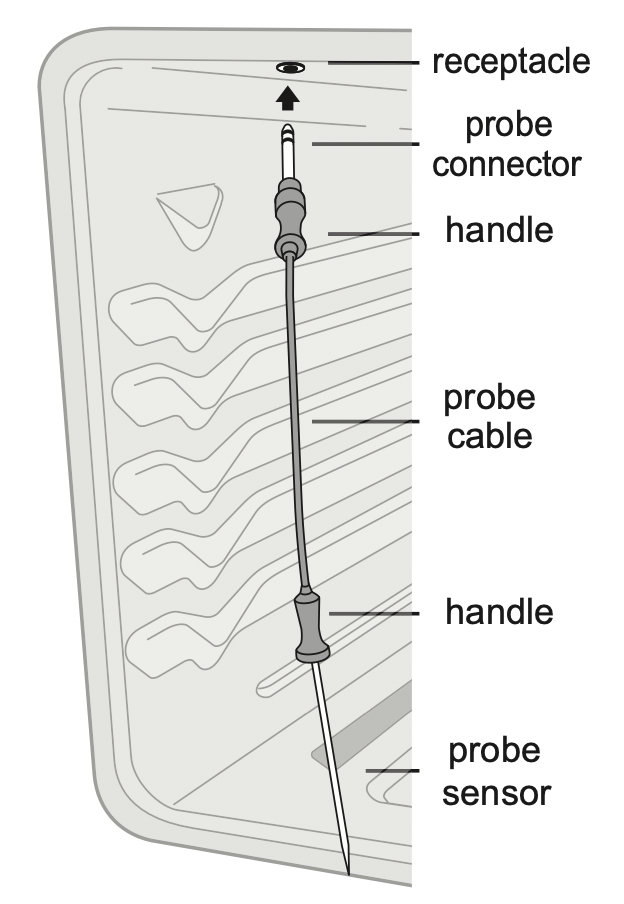
Figure 16: Using the probe
IMPORTANT:
Do not store the probe inside the oven. Use only the original probe provided. Connecting any other probe or device could result in damage to the oven control, electronics, and the receptacle.
Before starting self clean, double check that the probe is removed from the oven interior. Defrost frozen foods completely before inserting the probe.
Proper placement of probe in food.
Insert the meat probe so that the probe tip rests inside the center of the thickest part of meat or food (See Figure 17). For best results, do not allow the probe temperature sensor to contact bone, fat, gristle, or the cookware.

Figure 17: Probe in thickest area of food
- For bone-in ham or lamb, insert the probe into the center of lowest large muscle or joint.
- For meat loaf or casseroles, insert the probe into center of food.
- When cooking fish, insert meat probe just above the gill.
- For whole poultry or turkey, fully insert the probe sensor into the thickest part of the breast (See Figure 18).

Figure 18: Probe in thickest part of breast
To set probe:
- Insert the probe into the food. Place prepared food on the desired oven rack position and slide into the oven.
- Plug the connector end of the meat probe all the way into the probe receptacle while the oven is still cool. The receptacle is located on the upper left front oven cavity wall (See Figure 16). Close oven door.
- Set for Quick Preheat, Bake, Convection Bake, or Convection Roast and if necessary adjust the oven temperature accordingly.
- Press OK/START.
- Press Meat Probe. The Meat Probe default temperature of 170°F appears. Using the numeric keys set the desired internal food temperature for food type. (See Figure 19).
- Press OK/START to accept the target temperature.
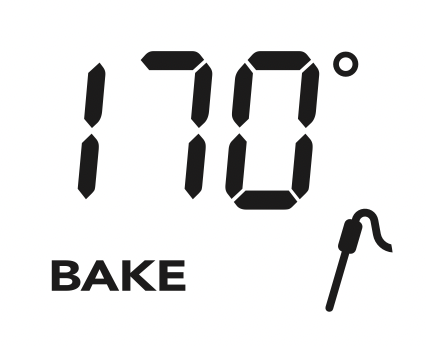
Figure 19: Probe set showing probe temperature
Note: The minimum setting is 140ºF (60ºC); the maximum is 210ºF (99ºC). Default is 170ºF (77ºC). - The control will provide three beeps when the internal target temperature is reached.
- When the internal target temperature is reached, the oven will automatically change to Hld setting and will maintain the oven temperature at 170°F (77°C) until canceled.
- To stop cooking at any time, press OFF.
NOTE
During cooking the internal food temperature will display by default. To see the target temperature press the meat probe key once. After 6 seconds the display will revert to the internal food temperature. To assure accuracy, do not remove the probe from the food or receptacle until the desired internal temperature is reached.
If the probe is removed from the receptacle only, the probe feature will cancel but the oven will continue to cook. If the probe is removed from the food only, the probe feature will remain active and may eventually generate a probe too hot message.
To change the target temperature while cooking, press the probe key once. Use the numeric keys to change the temperature. Press the OK/START key to accept any change.

To set how oven will operate once the probe reaches target temperature:
The oven is preset to automatically stop cooking and start the warm feature when probe sensor reaches the target temperature. This may be set to continue cooking if desired. Setting the options must be done when the oven is inactive. The meat probe is not required to be connected to the probe receptacle when setting this option.
To set the oven to continue cooking after reaching the target temperature:
- Press Meat Probe key and hold for 6 seconds.
- Press Self Clean key and toggle until Continu appears, then press OK/START to accept.
To set the oven to automatically stop cooking and start warm once reaching target temperature:
- Press Meat Probe key and hold for 6 seconds.
- Press the Self Clean key and toggle until CAnCEL appears then press OK/START to accept
Probe too hot message:
When the message Hot flashes in the display, the probe temperature has exceeded 250°F (121°C). If the probe is not removed, this message may continue until the sensor reaches 300°F (149°C) or higher, and oven will automatically turn off. Be sure the probe sensor is fully covered by the food.
Warm
Warm should only be used with foods that are fully cooked and at serving temperatures. Warm will keep foods warm and ready for serving at 170° F (77°C) until canceled.
To set Warm:
- If needed, arrange oven racks and place cooked food in oven.
- Press Warm: WARM will appear in the display. (If no other keys are touched within 25 seconds the request for Warm will clear.)
- Press OK/START. Warm will automatically turn on and remain on until cancelled.
Note: To turn Warm off at any time, press OFF.
WARNING: Food poisoning hazard. Do not let food sit for more than one hour before or after cooking. Doing so can result in food poisoning or sickness.
When using the Meat Probe for cooking, the Warm function will turn on automatically once the probe reaches the target temperature of the food. Warm will remain on at a serving temperature of 170°F until canceled.
Setting the Sabbath Feature (for use on the Jewish Sabbath and Holidays)
This appliance provides special settings for use when observing the Jewish Sabbath/Holidays. Sabbath mode disables all audible tones or visual display changes on the oven control. Bake is the only cooking feature available while in the Sabbath mode. Oven controls are locked during Sabbath mode.
You must first set the Bake feature and temperature(s) needed for the oven and Delay Start options (if needed). Any settings made prior to setting the Sabbath mode will be visible in the displays.
The Sabbath mode will override the factory preset 12 hour energy saving mode, and the appliance will stay on until the cooking features are canceled. If any of the cooking features are canceled when the appliance is in the Sabbath mode, no audible or visual indicators will be available to verify the cancellation.
If the oven interior lights are needed, be sure to activate them prior to setting the Sabbath mode. Once the oven light is turned on and the Sabbath mode is active, the oven light will remain on until the Sabbath mode is turned off and the oven lights are turned off. The oven door will not activate the interior oven lights when the oven door is opened or closed.
It is recommended that any oven temperature modification made within an active Sabbath mode be followed with two presses of the OK/START key. This will insure the oven remains on even if an attempt is made to set the oven temperature outside of its temperature range.
If the oven temperature is set outside of the temperature range, the oven will default to the nearest available temperature. Try to set the desired oven temperature again.
WARNING: Food poisoning hazard. Do not let food sit for more than one hour before or after cooking. Doing so can result in food poisoning or sickness. Foods that can easily spoil such as milk, eggs, fish, meat or poultry, should be chilled in the refrigerator first. Even when chilled, they should not stand in the oven for more than 1 hour before cooking begins, and should be removed promptly when finished cooking.
Important:
- Do not attempt to activate any other oven function except Bake while the Sabbath feature is active. The following keys will function correctly when the Sabbath feature is active: 0-9 number keypad, Bake, OK/START, and OFF. All other keys should not be used once the Sabbath feature is active.
- You may change the oven temperature once baking has started. Press Bake, use the numeric keypad to enter the oven temperature change (170°F to 550F°), and press OK/START (for Jewish Holidays only).
- Remember that the oven control will no longer provide audible tones or display any further changes when the Sabbath feature is active.
- The oven will remain on until canceled and therefore may only be used once during the Sabbath/Jewish Holidays.
- If a delay start time longer than 11 hours and 59 minutes is desired, set the oven control for the 24 hour day display mode setting. See “Setting 12 Hour or 24 Hour display mode” on page 14 for more information.
To program oven to Bake with default oven temperature of 350°F and activate the Sabbath feature:
- Be sure the clock is set with the correct time of day.
- Arrange oven racks, place bakeware in oven, and close oven door. Press Bake.
- Note: If Delay Start is desired enter the timeat this point.
See “Setting Delay Start” on page 19 for detailed instructions. - Press OK/START.
- Press and hold Self Clean and Delay Start simultaneously for about 3 seconds to set the Sabbath feature. Once the feature is set, SAb will appear in the display indicating the oven is properly set for the Sabbath feature (Figure 20).

Figure 20: Oven set for Sabbath baking
To turn the oven off and keep the Sabbath feature active:
- Press OFF.
To turn off the Sabbath feature:
Press and hold both Self Clean and Delay Start simultaneously for at least 3 seconds to turn the Sabbath feature off. The control will provide an acceptance tone, and SAb will disappear from the display. The oven is no longer programmed for the Sabbath feature.
What to do during a power failure or power interruption after the Sabbath feature was activated:
Should you experience a power failure or interruption, the oven will shut-off. When power is restored the oven will not turn back on automatically. The oven will remember that it is set for the Sabbath, and the oven display will show the message SF for Sabbath failure (Figure 21).

Figure 21: Display showing Sabbath failure
The food may be safely removed from the oven while still in the Sabbath feature, however the oven cannot be turned back on until after the Sabbath/Holidays. After the Sabbath observance turn off the Sabbath feature.
Press and hold both Self Clean and Delay Start keys for at least 3 seconds simultaneously to turn the Sabbath feature off. SF will disappear from the display, and the oven may be used with all normal functions.
Restoring Factory Default Settings
Your appliance was set with predetermined (default) oven control settings. Over time, users may have made changes to these settings. The following options may have been modified since the appliance was new:
- 12 or 24 hr display mode
- All Meat Probe settings
- Continuous bake or 12 hour energy savings mode
- Silent or audible control
- Oven temperature display (Fahrenheit or Celsius)
- Oven temperature adjustments (UPO)
CAUTION: All of the above user settings will be restored to the factory default settings.
To restore oven control to factory default settings:
- Press and hold 7 on numeric keypad until acceptance tone sounds (about 6 seconds).
- Press OK/START. The control has been reset with the default settings.
Adjusting Oven Temperatures
Your appliance has been factory calibrated and tested to ensure accurate baking temperatures. For the first few uses, follow your recipe times and temperature recommendations carefully. If you think the oven is cooking too hot or too cool for your recipe times, you may adjust the control so the oven cooks hotter or cooler than the oven temperature displayed.
Important: Do not use oven thermometers such as those found in grocery stores to check the temperature settings inside your oven. These oven thermometers may vary as much as 20 to 40°F degrees from actual temperatures.
The oven temperature may be increased as much as +35°F (+19°C) or decreased -35°F (-19°C) from the factory calibrated settings.
To increase or decrease the oven temperature by 20°F:
- Press and hold Bake until the control produces an audible tone (about 6 seconds). The factory offset temperature of 0 (zero) should appear in the display.
- Enter 2 0 using numeric keypad.
- To offset the oven by -20°F, press self clean to toggle between + and -.
- Press OK/START to accept change.
Important note:
- Oven temperature adjustments will not change the Broil, Self Clean, or Keep Warm temperatures.
- The oven temperature adjustment may be made if your oven control is set to display temperatures in °C (Celsius). Minimum and maximum settings for Celsius range from plus (+)19°C to minus (-) 19°C.
Self Clean
A self cleaning oven cleans itself with high temperatures (well above normal cooking temperatures), which eliminate soils completely or reduces them to a fine powdered ash you can wipe away afterwards with a damp cloth. This function can be programmed for clean times between 2 and 4 hours.
Important: Before starting self clean read all following caution and important statements before starting a self clean cycle.
CAUTION
- Do not leave small children unattended near appliance. During self clean cycle, the outside of the oven can become very hot and cause burns if touched.
- Do not line the oven walls, racks, oven bottom, or any part of the range with aluminum foil. This will cause permanent damage to the oven interior and destroy heat distribution, and will melt to the oven interior.
- Do not force the oven door open. This will damage the automatic door locking system. Use caution when opening the oven door after the self clean cycle ends. The oven may still be very hot and cause burns. To avoid possible burns, stand to side of oven when opening door to allow steam or hot air to escape.
- The health of some birds is extremely sensitive to fumes given off during the self clean cycle of any range. Move birds to a well ventilated room.
Important notes:
- Completely remove all oven racks and any accessories from oven cavity to avoid damage to oven racks. If the oven racks are not removed they may discolor.
- Remove all items from the oven and cooktop including cookware, utensils, and any aluminum foil. Aluminum foil will not withstand high temperatures from a self clean cycle and will melt.
- Do not spray oven cleaners or oven protective coatings in or around any part of the oven interior. Clean any soil from the oven frame, the door liner outside the oven door gasket, and the small area at the front center of the oven bottom (Figure 22). These areas heat sufficiently to burn soil on. Clean using soap and water prior to starting Self Clean.
- Remove any excessive spills. Any spills on the oven bottom should be wiped up and removed before starting a self clean cycle. To clean use hot, soapy water and a cloth. Large spills can cause heavy smoke or fire when subjected to high temperatures.
- Do not allow food spills with high sugar or acid content (such as milk, tomatoes, sauerkraut, fruit juices, or pie fillings) to remain on the surface as they may leave a dull spot even after cleaning.
- Do not clean the oven door gasket. The woven material in the gasket is essential for a good seal. Care should be taken not to rub, damage, or remove the oven door gasket. Doing so could cause damage to the door gasket and compromise the performance of the oven.

Figure 22: Areas to clean and areas to avoid (gasket)
- The kitchen area should be well ventilated using an open window, ventilation fan, or exhaust hood during the first self clean cycle. This will help eliminate the normal odors.
- Do not attempt to open the oven door when the OVEN LOCK indicator light is flashing. Allow about 15 seconds for the motorized door latch mechanism to completely lock or unlock the oven door.
- When the clean time finishes, the oven door will remain locked until the range has cooled sufficiently. In addition to the clean time that was programmed, you must allow about 1 additional hour for the oven to cool before you will be able to open the oven door.
Setting Self Clean
To set self clean:
- Be sure the oven is empty and all oven racks are removed. Remove all items from the oven. Be sure oven door is completely closed.
- Press Self Clean.
- A 3 hour clean time will appear in the display. You may accept the 3 hour clean time or choose a different clean duration by entering any time between 2 and 4 hours clean time by entering the time using the numeric keys.
- Press OK/START twice to activate self clean.
- The warning to REMOVE RACKS will flash in the display and beep for 30 seconds to remind you that oven racks should be removed before a self clean.
- The warning will end and Self Clean will start. The motor door lock will begin locking the oven door.
Important: Do not open the oven door while the lock motor is running or when any locking indicators or displays are showing. The oven door is completely locked in about 15 seconds. Once the oven door has locked, CLEAN will appear in the display indicating self clean has started.
Do not force the oven door open when self-clean is active. This can damage the automatic door-locking system. Use caution when opening the door after self-clean cycle is complete; the oven may still be very hot.
When self clean is finished:
- CLEAN message will turn off, and Hot will appear in display window.
- Once the oven has cooled down (about 1 hour) and Hot is no longer displayed, the oven door may be opened.
- When the oven interior has completely cooled, wipe away any residue or powdered ash with a damp cloth or paper towel.
CAUTION: To avoid possible burns, use care when opening the oven door after the self-cleaning cycle. Stand to the side of the oven when opening the door to allow hot steam and air to escape.
Setting Delay Start Self Clean
To start a delay self clean with default clean time of 3 hours and a start time of 9:00 o’clock:
- Be sure the clock is set with the correct time of day, the oven is empty, and all oven racks are removed. Be sure oven door is completely closed.
- Press Self Clean
- Press Delay Start.
- Using numeric keypad, enter 9 0 0.
- Press OK/START twice to accept.
If it becomes necessary to stop self clean when active:
- Press OFF.
Important: If self clean has heated the oven to a high temperature, allow enough time for the oven to cool. Before restarting self clean, be sure to read important notes below.
Important note:
- If your clock is set with the (default) 12 hr display mode, the delay start for a self clean can only be programmed to start up to 11 hours and 59 minutes after the time showing in the display (be sure to set the clock to current time before programming a Delay Start). To set a delay start Self Clean to begin 12 or more hours (maximum is 23 hours and 59 minutes) after the time of setting, be sure to first set the control in the 24 Hr display mode.
- If self clean was active and then interrupted by a power failure or canceled before the oven was thoroughly cleaned, it may be necessary to run another self clean cycle.
- If the oven temperature was high enough when self clean was interrupted the oven control may not allow another self clean cycle to be set for up to 4 hours.
Steam Clean
The Steam Clean feature offers a chemical free and time saving method to assist in the routine cleaning of small and light soils. For heavier baked on soils use the Self Clean feature.
CAUTION: Do not add bleach, ammonia, oven cleaner, or any other abrasive household cleaners to the water used for Steam Clean. Before cleaning any part of the oven, be sure all controls are turned off and the oven is cool. The oven may be hot and can cause burns.
Be sure the oven is level and cool before starting Steam Clean. If the oven temperature is above room temperature a triple beep will be heard and the function will not start. Steam Clean produces best results when started with a cool oven
To set a Steam Clean cycle:
- Remove all racks and oven accessories.
- Scrape or wipe loose debris and grease from the oven bottom.
- Pour 1 cup of tap water onto the oven bottom. (Figure 23) Close oven door.
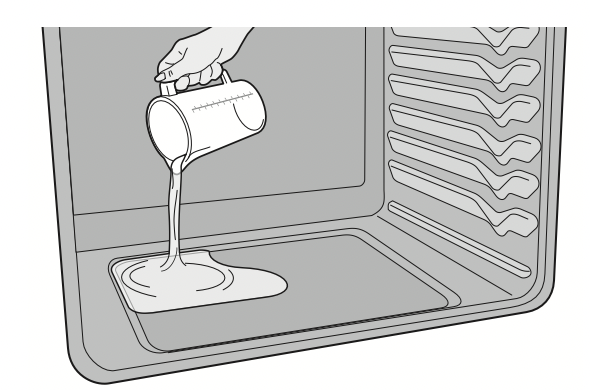
Figure 23: Add 1 cup of tap water - Press Steam Clean.
- Press OK/START. St C will appear in the display.
- To see time remaining in the Steam Clean cycle press Steam Clean key. The time left will show in the display for 6 seconds before returning to the time of day. Do not open the door during this time. If door is open during Steam Clean for more than 4 minutes, d-O will appear in the display and the display will sound a triple beep until the door is closed.
- When the steam clean cycle is complete an alert will sound and the END message will show in the display. Press OFF to return to the clock.
- Take care opening the door when the steam clean is finished. Stand to the side of the oven out of the way of escaping vapor.
- Wipe oven cavity and bottom. Do not clean oven door gasket (Figure 24). Avoid leaning or resting on the oven door glass while cleaning cavity.
- To cancel Steam Clean at any time press OFF.

Figure 24: Clean around the oven door gasket
Important: Opening oven door during Steam Clean cycle prevents the water from reaching the temperature needed to clean. If the door is left open once Steam Clean starts, an alarm will sound alerting you to close the door.
- For best results, clean oven immediately after the cycle is complete. Steam clean works best for soils on the oven bottom.
- Place a paper towel or cloth in front of the oven to capture any water that may spill while wiping out.
- A non abrasive scouring pad, stainless steel sponge, plastic scraper, or eraser style cleaning pad (without cleaner) can be used for difficult soils. Moisten pads with water before use.
- Do not leave the residual water in the oven for any length of time.
- Some condensation or water vapor may appear close to the oven vent. This is normal. The oven gasket may become damp; do not wipe dry.
- Local water sources often contain minerals (hard water). If hard water deposits occur, wipe cavity with a 50/50 solution of water and vinegar or 50/50 solution of lemon juice and water.
- Steam clean cannot be programmed with a delay start.
- If Steam Clean results are not satisfactory, run a Self Clean. See “Self Clean” on page 30.
CARE AND CLEANING
Remove spills and any heavy soiling as soon as possible. Regular cleaning will reduce the difficulty of major cleaning later.
CAUTION
- Before cleaning any part of the appliance, be sure all controls are turned off and the appliance is cool.
- If ammonia or appliance cleaners are used, they must be removed and the appliance must be thoroughly rinsed before operating. Follow manufacturer's instructions and provide adequate ventilation.
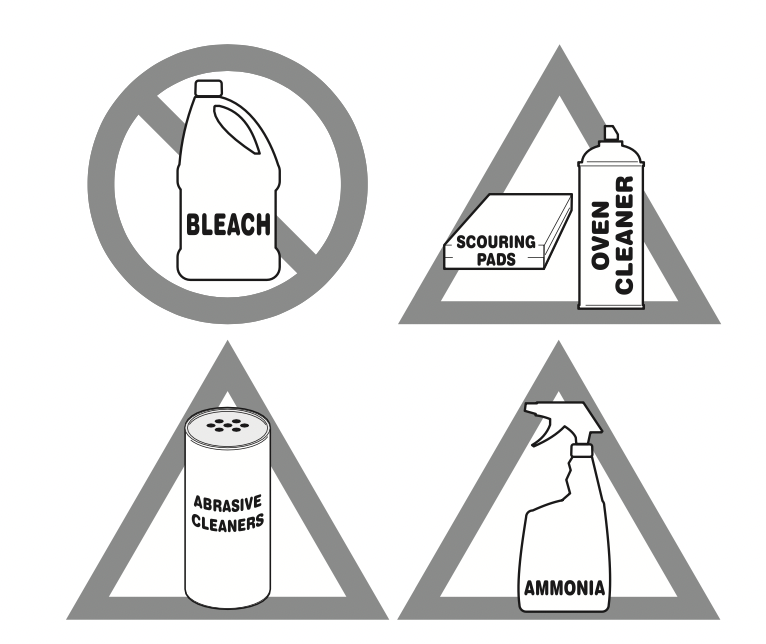
Figure 25: Use cleaners with caution
Cleaning Various Parts of Your Oven
Before cleaning any part of the oven, be sure all controls are turned off and the oven is cool. Remove spills and any heavy soiling as soon as possible. Regular cleaning will reduce the number of major cleaning later.
| Surface or Area |
Cleaning Recommendation |
|---|---|
|
Aluminum and vinyl |
Using a soft cloth, clean with mild dish detergent and water. Rinse with clean water, dry and polish with a soft, clean cloth. |
|
Painted and plastic control knobs Painted body parts Painted decorative trims |
Using a soft cloth, clean with mild dish detergent and water or a 50/50 solution of vinegar and water. Rinse with clean water, dry and polish with a soft, clean cloth. Glass cleaners may be used, but do not apply directly to surface; spray onto cloth and wipe. |
| Control panel |
Using a soft cloth, clean with mild dish detergent and water or a 50/50 solution of vinegar and water. Do not spray liquids directly on the oven control and display area. Do not use large amounts of water on the control panel - excess water on the control area may cause damage to the appliance. Do not use other liquid cleaners, abrasive cleaners, scouring pads, or paper towels - they will damage the finish. |
| Stainless Steel |
Using a soft cloth, clean with mild dish detergent and water or a 50/50 solution of vinegar and water. Rinse with clean water, dry with a soft clean cloth. Do not use cleaners containing abrasives, chlorides, chlorine, or ammonia. |
|
Smudge Proof™ Stainless Steel Black Stainless Steel |
Using a soft cloth, clean with mild dish detergent and water or a 50/50 solution of vinegar and water. Rinse with clean water, dry with a soft clean cloth. Do not use appliance cleaner, stainless steel cleaner, or cleaner containing abrasives, chlorides, chlorine, or ammonia. These cleaners may damage the finish. |
|
Porcelain-enameled broiler pan and insert Porcelain door liner Porcelain body parts |
Rinse with clean water and a damp cloth. Scrub gently with a soapy, non-abrasive scouring pad to remove most spots. Rinse with a 50/50 solution of clean water and ammonia. If necessary, cover difficult spots with an ammonia-soaked paper towel for 30 to 40 minutes. Rinse and wipe dry with a clean cloth. Remove all cleaners or future heating could damage the porcelain. Do not allow food spills with a high sugar or acid content (milk, tomatoes, sauerkraut, fruit juices or pie filling) to remain on porcelain surfaces. These spills may cause a dull spot even after cleaning. |
|
Self-cleaning oven interior |
Before setting a self-clean cycle, clean soils from the oven frame, areas outside the oven door gasket, and the small area at the front center of the oven bottom. See “Self Clean” on page 30. |
| Oven door |
Use mild dish detergent and water or a 50/50 solution of vinegar and water to clean the top, sides, and front of the oven door. Rinse well. Glass cleaner may be used on the outside glass of the door. Ceramic smoothtop cleaner or polish may be used on the interior door glass. Do not immerse the door in water. Do not spray or allow water or cleaners to enter the door vents. Do not use oven cleaners, cleaning powders, or any harsh abrasive cleaning materials on the outside of the oven door. |
General Cleaning
Refer to the table at the beginning of this chapter for more information about cleaning specific parts of the oven.
CAUTION
Before manually cleaning any part of the oven, be sure all controls are turned off and the oven is cool. The oven may be hot and can cause burns.
Remove all racks and accessories from the oven before cleaning.
Ammonia must be rinsed before operating the oven. Provide adequate ventilation.
Follow these cleaning precautions:
- Allow the oven to cool before cleaning.
- Wear rubber gloves when cleaning the appliance manually.
Remove soils using hot, soapy water. Do not allow food spills with a high sugar or acid content (such as milk, tomatoes, sauerkraut, fruit juices or pie filling) to remain on the surface as they may cause a dull spot even after cleaning. Remove spillovers and heavy soiling as soon as possible. Regular cleaning will reduce the effort required for major cleaning later.
Broiler Pan Cleaning Tips
To prevent grease from baking on, remove the broiler pan from the oven as soon as cooking is completed. Use oven mitts because the broiler pan is extremely hot. Pour off grease. Soak the pan in hot, soapy water.
Clean the broiler pan as soon as possible after each use. If necessary, use soap-filled steel wool pads. Heavy scouring may scratch the grid.
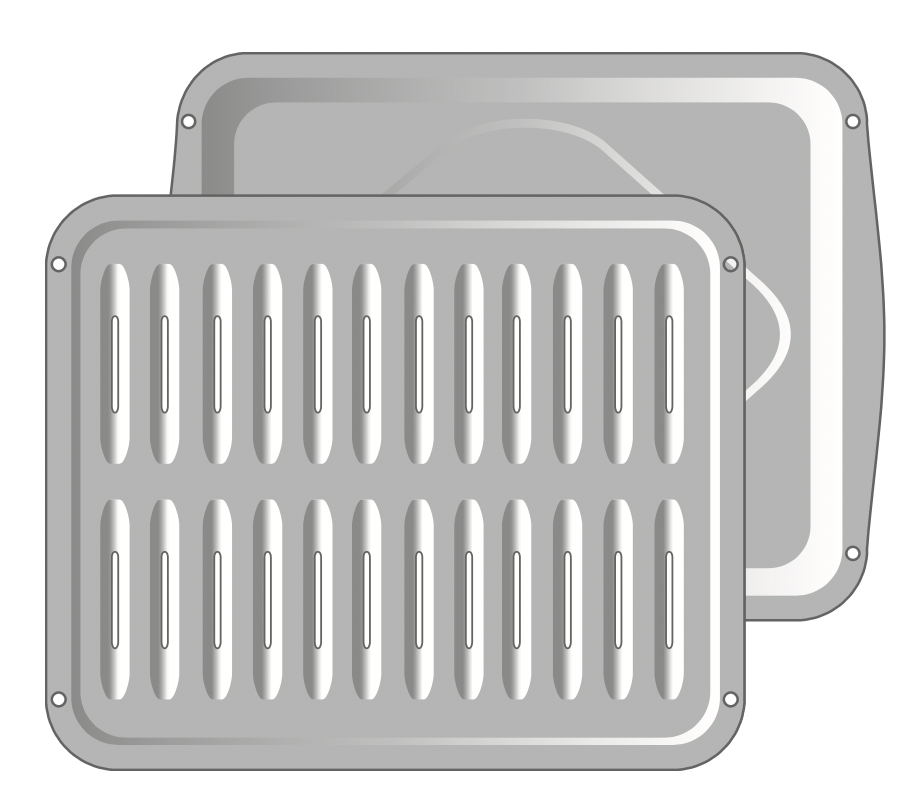
Figure 26: Broiler pan with insert
Aluminum Foil, Aluminum Utensils, and Oven Liners
WARNING: Never cover any slots, holes, or passages in the oven bottom or cover an entire oven rack with materials such as aluminum foil. Doing so blocks air flow through the oven and may cause carbon monoxide poisoning. Aluminum foil linings may trap heat, causing a fire hazard.
- Protective liners - Do not use aluminum foil to line the oven bottom. The high heat of the oven can melt these materials to the oven cavity and ruin the oven. These types of materials can also reduce the effectiveness of the air circulation in the oven and produce poor baking results. Only use aluminum foil as recommended in this manual. Improper installation of these liners may result in risk of electric shock or fire.
- Aluminum utensils - The melting point of aluminum is much lower than that of other metals. Care must be taken when aluminum pots or pans are used.
- Oven racks - Do not use aluminum foil to cover the oven racks. Using a liner in the oven restricts the heat and air flow needed to obtain the best possible cooking results for any oven.
Replacing the Oven Light
CAUTION: Be sure the oven is unplugged and all parts are cool before replacing the oven light.
The interior oven light is located at the rear of the oven cavity and is covered by a glass shield. The glass shield must be in place whenever the oven is in use (Figure 27).
To replace the oven interior light bulb:
- Turn electrical power off at the main source or unplug the appliance.
- Remove interior oven light shield by turning a quarter turn counter-clockwise.
- Replace bulb with a new T-4 type Halogen 25 watt appliance bulb.
NOTE: Wear a cotton glove or use a paper towel when installing a new bulb. Do not touch the new bulb with your fingers when replacing. This will shorten the life of the bulb. - Replace glass oven light shield by rotating clockwise.
- Turn power back on again at the main source (or plug the appliance back in).
- Be sure to reset the time of day on the clock
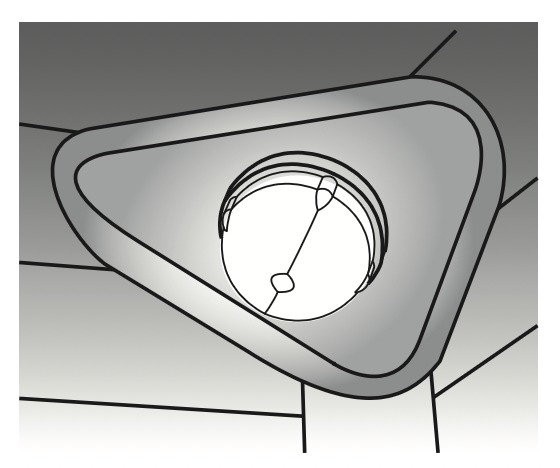
Figure 27: Wall oven Halogen light
Removing and Replacing the Oven Door
IMPORTANT
Special door care instructions - The door is heavy. For safe, temporary storage, lay the door flat with the inside of the door facing down.
Most oven doors contain glass that can break. Do not close the oven door until all the oven racks are positioned correctly in the cavity. Do not hit the glass with bakeware or any other objects. Scratching, hitting, jarring, or stressing the glass may weaken its structure, causing an increased risk of breakage at a later time.
To remove the oven door:
- Open oven door completely, horizontal with floor.
- Pull up the lock located on each hinge support toward front of the oven until the lock stops. You may have to apply a little upward pressure on the lock to pull it up (Figure 29 and Figure 30).
- Grasp the door by the sides, and close the door until the door frame makes contact with the unlocked hinges.
- Pull the bottom of the door toward you while rotating the top of the door toward the appliance to completely disengage the hinge levers (Figure 31).
To Replace Oven Door:
- Firmly grasp both sides of oven door along the door sides. Do not use the oven door handle (Figure 31).
- Hold the oven door at the same angle as the removal position. Carefully insert the hinge levers into the oven frame until you feel the hinge levers are seated into the hinge notches. The hinge arms must be fully seated into the hinge notches before the oven door can be fully opened. (Figure 31).
- Fully open the oven door, horizontal with floor (Figure 28).
- Push the door hinge locks up toward and into the oven frame on both left and right oven door hinges to the locked position (Figure 29)
- Close the oven door.

Figure 28: Door hinge location

Figure 29: Door hinge locked

Figure 30: Unlocking door hinge

Figure 31: Remove door position
Caring for Your Glide Racks
Caution: Handle oven racks only when they are cool. After cooking or after the fresh-clean cycle, racks will be very hot and can cause burns.
Important Notes:
- Remove all oven racks, including ladder racks, before starting a clean cycle.
- Do not use cooking oil, cooking spray, or other oil-based lubrication products on the glide rack extension tracks. Use only the graphite lubrication in this area. To order graphite lubrication, contact your installer, servicer or dealer.
- It is important that the parts of the rack that contact the oven sides always have a light coating of vegetable oil. Apply a thin layer of vegetable oil to the sides of the rack after every fresh-clean cycle and when the rack becomes difficult to reposition in the oven.
To lubricate the glide rack:
- Remove the rack from the oven and place the rack on a large flat surface covered with newspaper or scrap cloth. Fully extend the rack.
- Wipe away debris and crumbs from the glide track using a cloth or sponge.

- Shake graphite lubrication very well before applying.
Apply to loading guides, and rotation pin. Repeat on both sides of the glide rack.
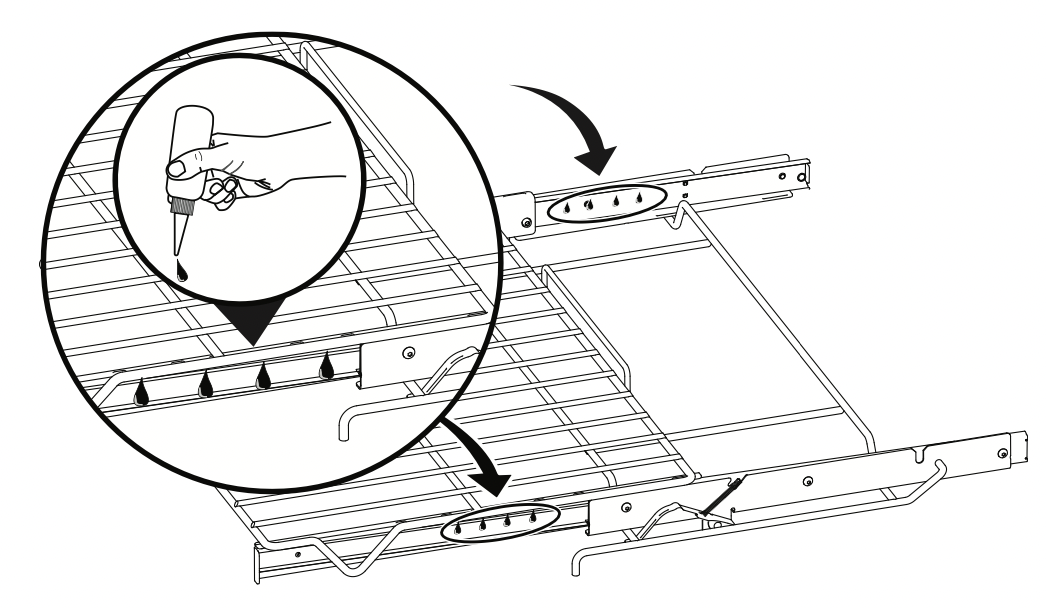
- Extend and return the glide rack several times along the tracks to distribute the lubrication.

- Turn the rack upside down and apply graphite l tion to the insides of the loading guides.

- Extend and return the glide rack several times along the tracks to distribute the lubrication.
- Apply a thin layer of cooking oil to the bottom of the “V” and the glide channels. Keeping the frame sides lightly lubricated allows the entire rack to slide easily when changing rack positions.

- Replace rack in oven right-side up.
TROUBLESHOOTING
Solutions to Common Baking Problems
For best cooking results, fully preheat the oven before baking cookies, breads, cakes, pies or pastries, etc.
There is no need to preheat the oven for roasting meat or baking casseroles.
The cooking times and temperatures needed to bake a product may vary slightly from your previously owned appliance.
Baking Problems and Solutions Chart
| Baking Problems | Causes |
Corrections |
|---|---|---|
|
Cookies and biscuits burn on the bottom.
|
|
|
|
Cakes too dark on top or bottom.
|
|
|
|
Cakes not done in center.
|
|
|
|
Cakes not level.
|
|
|
|
Foods not done when cooking time is over.
|
|
|
Solutions to Common Problems
Before you call for service, review the following list. It may save you time and expense.
Possible solutions are provided with the problem listed:
| Problem |
Solution |
|---|---|
| Oven control panel beeps and displays error codes |
|
| Poor baking results |
|
| Quick Preheat performs poorly |
|
| Appliance is not level |
|
|
Cannot move appliance easily Appliance must be accessible for service |
|
| Appliance does not operate |
|
| Flames inside oven or smoking from oven vent |
|
| Oven does not operate. |
|
| Oven smokes excessively when broiling. |
|
|
Oven racks discolored or do not slide easily. |
|
| Oven light does not work. |
|
| Fan noise occurring after the oven is turned off. |
|





